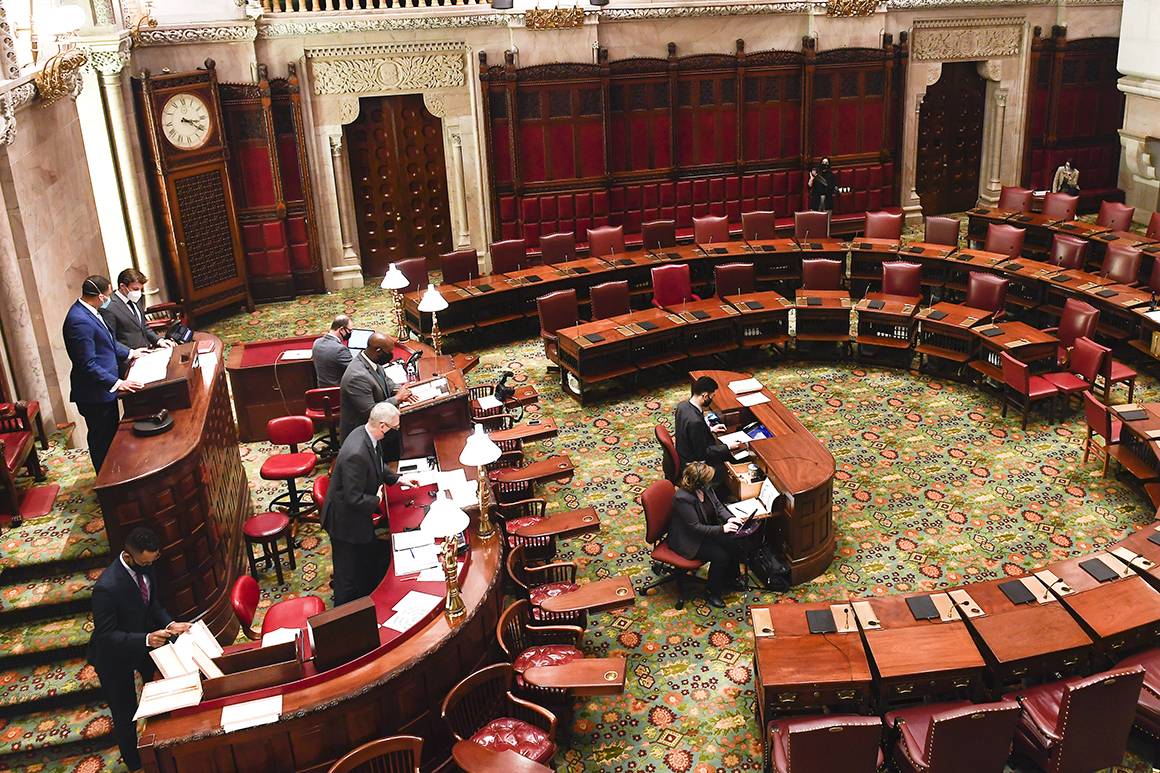
The Senate Chamber floor is pictured during a Legislative Session at the New York state Capitol in Albany, N.Y. | Hans Pennink/AP Photo
ALBANY, N.Y. — Former Gov. Andrew Cuomo’s signature structural change to state government during his first term was an overhaul of political mapmaking in New York. A new “Independent Redistricting Commission” would “permanently reform the redistricting process in New York to once and for all end self-interested partisan gerrymandering,” he promised.
That bipartisan commission flunked its biggest test on Monday, with its 10 members deadlocking 5-5 on a pair of competing proposals.
“This was an abject failure,” said commissioner Ross Brady, who is allied with the Republican members.
That leaves the redistricting process exactly as it was a decade ago. State lawmakers are now likely to reject both of the commission’s plans and draw the maps themselves. And success is not a given — the Legislature’s Democratic majorities need near unanimity and will have to fend off any GOP court challenges.
But the commission’s stalemate eases the way for the most pro-Democratic gerrymandering in the history of New York, the country’s second most-populous Democratic stronghold. That could provide a major boost to the party as it seeks to maintain control of the House of Representatives. There’s now a smoother path for new lines that would help increase the size of New York’s 19-member Democratic congressional delegation to 22 or potentially 23, even as the number of seats shrinks from 27 to 26.
Such an outcome might have been predictable, in part because a state constitutional amendment that created the commission left a path for the Legislature to vote down its lines twice and then return to their old mapmaking habits.
“The independent commission was formed as a false positive step by Cuomo, because its recommendations don’t have to be followed,” said Democratic activist Bill Samuels, who helped lead the opposition to the amendment. “At the time it was set up, most of us said it was meaningless.”
The commission came about when former New York City Mayor Ed Koch made a push for redistricting reform the last act in his colorful life. Cuomo had pledged to veto any gerrymandered lines while seeking his first term in 2010. Koch’s activism on the subject made it impossible for Cuomo to back away from that promise without suffering significant blowback. But legislators were unwilling to surrender their traditional prerogative, and the amendment to make some changes starting in the 2020s represented the best possible path for minimizing the backlash from either lawmakers or Koch.
While it didn’t go as far as Cuomo had initially promised, the amendment did leave some safeguards against one-party gerrymandering in place.
Much to the chagrin of other Democrats, Cuomo’s amendment effectively said that if the party ever won control of the state Senate, new lines would need two-thirds supermajorities in both that chamber and the Assembly, which Democrats have dominated since Watergate. At the time, the notion of Democrats winning 42 of the state Senate’s 63 seats was considered highly unlikely. Then came Donald Trump and an ensuing blue wave election in 2018. Democrats now have 43 seats in the Senate.
The amendment also allowed for the possibility that the commission could actually reach an agreement. In that scenario, with Democratic and Republican commissioners coming together around one set of lines, legislators might have faced intense pressure to go along with the maps.
But Monday’s vote calls into question whether a commission with five members allied with Democrats and five with Republicans, most of whom are appointed by legislative leaders, can ever work as advertised.
“It wasn’t an independent commission … The entire way it was set up was problematic from the beginning,” said Susan Lerner of Common Cause New York. Lerner, the executive director of the civic activist group, won a 2014 lawsuit asking a court to block the appearance of the word “independent” on the ballot when the constitutional amendment went to voters as a referendum, arguing it was misleading to give the commission that label.
Assuming commissioners don’t find a way to strike a deal when they draw a second set of maps later this month, there are only a couple of roadblocks preventing a mapmaking process dominated by Democrats.
For one, they’ll need to remain unified. Democrats have the necessary two-thirds majorities in both chambers. But they don’t have a lot of breathing room in either. If any blocs of members — such as the handful of socialists in each house — make demands that are unacceptable to their colleagues, then the majorities might need to start looking for some Republican votes, which would certainly complicate things.
But what if they find the votes? The only thing saving Republicans from being redistricted into oblivion could well be anti-gerrymandering language in the amendment, such as a prohibition on drawing lines “to discourage competition.”
Language like that is “far from adequate,” Lerner said. Several attorneys have argued over the years that the only hope for winning a court case on such a phrase would involve Democrats being foolish enough to leave a paper trail in which they explicitly say they’re gerrymandering a district. But it’s enough to guarantee that Republicans aren’t going to surrender anytime soon.
“This is unprecedented that we have the standards that are now in the constitution, and no court has ever interpreted the standards,” said former U.S. Rep. John Faso, a Republican. “So I think it’s a big gamble for them if they try to overreach and do an extreme partisan gerrymandering.”





